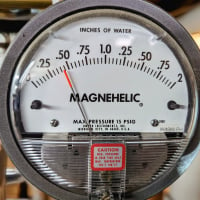Wait time/process for holding a vacuum...

Quick question for people with more knowledge than myself…
When you pull a vacuum on a mini split (with a micron gauge) and get it down to your goal (let's say 150 microns for an example), how long do you typically wait to check that the level is stable before being happy to continue?
And do you continue even if there is a VERY slow rise after the 10 minutes, provided iot stays below 500?
The reason I ask is recently I posted here on a very slow rise during a vacuum. From memory I vacuumed to 220 microns, and it went up some in a 10 minute test. But continued to go up by 10 microns every 7-8 minutes approximately, and finally stopped at 360 microns after 45 minutes (so I finished the job).
My thought process is that if there is any physical leak you won't be able to hold a vacuum anywhere near under 500, and it will shoot up very quickly.
So I'm wondering if most people here vacuum down to target, and then do a ten+ minute test, and if it's still under 500 after 10 minutes then consider that fine, and finish the job (even if there is a very slow continual rise)?
Thoughts, opinions and experiences very welcome 👍️
Comments
-
In my experience, the system is tight and dry.
But, when it comes to leaks that part I have some questions of my own for others. Even at a perfect vacuum the absolute most pressure the system has pushing against it is only 14.7 psi (atmosphere pressure), obviously from the outside. This is nothing compared to a 400-600 psig nitrogen pressure test, or even the 300+ psi refrigerant pressure some parts of the system may see.
Is it actually possible, or even likely a system with a small leak at 300 psi wouldn't leak at all in a deep vacuum? Or if it did, would it be so slow no one would notice?Single pipe 392sqft system with an EG-40 rated for 325sqft and it's silent and balanced at all times.
0 -
It stopped at 360 then its tight!
Pulling to 150 is overkill. Get it to 4-500 and let it sit, if it doesn't rise above 1000 your good to go. This is assuming new line sets, not repairs on existing systems.
It's also assuming a proper set up. No Manifold hoses.
0 -
"Get it to 4-500 and let it sit, if it doesn't rise above 1000 your good to go"
How long do you typically let it sit for? Do you have a typical time to wait, and if it's under 1000 at the end of that time then complete the job?
Or do you wait for it to stop slowly rising (regardless of how long this may take) and sit on a measurement for a set period of time?
Mine went up 10 microns every 7-8 minutes for 45 minutes. I'm thinking I may have wasted 35 minutes.
Is 10 minutes enough to know that you're vacuum is all good (assuming it does not rise above 500/1000 during the 10 minutes)?
0 -
I pull the vacuum and start with the electrical work. Depending on the job maybe 1 or 2 hours sitting. Every job is different. There are always hundreds of things to do while you wait.
0 -
So basically you pull the vacuum, move on to electrics etc, and then come back and if it's under 1000 finish it off?
What if you had a slow 10 microns every 7-8 minutes like I did? Would you wait longer to see if it stops, or provided it's under 1000 when you come to finish then finish it off regardless?
For example, you pull it to 500, do electrics, come back (let's say an hour later) and it's on 630, and you see it change to 640 when you happen to look at it. Do you finish it off regardless because it's under 1000, or does the slow rise give any cause for concern?
0 -
this is not an exact science. Every job is unique, every job will have different issues. You use your best judgment.
0 -
Fully appreciated. Just trying to expand my knowledge (to have better judgement I guess, lol!).
What would you do in this instance, interested to know how someone with more experience and knowledge than me would proceed…
—For example, you pull it to 500, do electrics, come back (let's say an hour later) and it's on 630, and you see it change to 640 when you happen to look at it. Do you finish it off regardless because it's under 1000, or does the slow rise give any cause for concern?—
What would you do in this instance?
0 -
if it’s not holding I do something else.
0 -
Perfect, thank you. That's mainly what I was wondering as I see a lot of people running 10 minutes checks, and having done a few systems already I've not seen one lock solid within 10 minutes.
The last one took 45+ minutes.
I wondered if:
a) People just run a certain period of time and if it's still under 500/1000 after that time then just go for it.
OR
b) Wait until you are definitely see no increase at all within a reasonable time period (probably 10+ minutes without any increase - regardless of how long or if you are still under 500/1000).
And it seems that answer is b 👍️👍️👍️
Thank you 🙂
0 -
Out of interest, what would that be?
0 -
electrical
Clean up
Armorflex
There’s always something to do.
0 -
evacuated…
0 -
It is possible but unlikely that a particle or especially a resilient seal could plug a hole tightly under pressure and act like a check valve and let air in under vacuum.
0 -
No, that I understand.
I worded it poorly.
I mean if someone doesn't pressure test, but then the system holds a 100 micron vacuum, is it still possible for it to leak under pressure. I assume yes, very.
Single pipe 392sqft system with an EG-40 rated for 325sqft and it's silent and balanced at all times.
0 -
oh, absolutely. technically it probably was leaking under vacuum but it was so slow you couldn't detect it. It will leak a lot faster at a differential of 200 psi or 400 psi than at ~15 psi.
I wonder how many of the people installing mini splits even own a micron gauge.
0 -
Most of what I did was back in the day when micron gauges were seldom used so we relied on pressure testing. If I had the time I would pressure test overnight. Many times, you couldn't do that so you would give it an hour or so.
Holding a pressure test does not mean the system is moisture free, however. In the early 2000s we had analog vacuum gauges which were troublesome. The newer gauges came out shortly after.
Its something you get a feel for. You learn how to braze and flare tubing and after a while you "know your joints", you pressure test and then vac it down and after a while you get a good feel for what you're doing.
Are you ever 100% sure? Not always.
Do you go home at the end of the day wondering if it tight? Occasionally. But after a while you know.
It also depends on whether this is a new system and you're just doing the line set and the indoor coil or you made a repair and have oil in the system. Two different things.
Takes a while to get the hang of it.
0 -
Yes, that's true. But likely with a physical leak such as a flare you'd not be able to pull a vacuum down to sub 1000 microns anyway? And it certainly wouldn't hold even if you did. What do you think?
0 -
I don't know.
a very small leak with a film of oil sealing it that 14.7 psi can't move…. I use nylog when making my flares, I'm sure I'm not alone. Which means a little gets left on the face etc.
Just something I've wondered about.
Single pipe 392sqft system with an EG-40 rated for 325sqft and it's silent and balanced at all times.
0 -
You can increase you chances of finding a leak under pressure by putting a piece of tape on the gauge and making 3 marks on it, 2 lining up with marks on the scale and a 3rd lining up with the needle, this way you can look at it the same way you did when you marked it to detect small movements of the needle. A mirrored gauge will do the same thing.
There were micron gauges at that time but they were a huge box that you had to plug in.
0 -
Can't really imagine not doing it without a micron gauge now TBH. It would be impossible to spot the very slow increase I experienced of around 10 microns every 7-8 minutes (before stopping after 45 minutes approx) without one.
That said, that could take the panic out completely and probably make it easier, lol!!!
0
Categories
- All Categories
- 87.3K THE MAIN WALL
- 3.2K A-C, Heat Pumps & Refrigeration
- 61 Biomass
- 427 Carbon Monoxide Awareness
- 119 Chimneys & Flues
- 2.1K Domestic Hot Water
- 5.8K Gas Heating
- 115 Geothermal
- 165 Indoor-Air Quality
- 3.7K Oil Heating
- 76 Pipe Deterioration
- 1K Plumbing
- 6.5K Radiant Heating
- 395 Solar
- 15.6K Strictly Steam
- 3.4K Thermostats and Controls
- 56 Water Quality
- 51 Industry Classes
- 49 Job Opportunities
- 18 Recall Announcements

